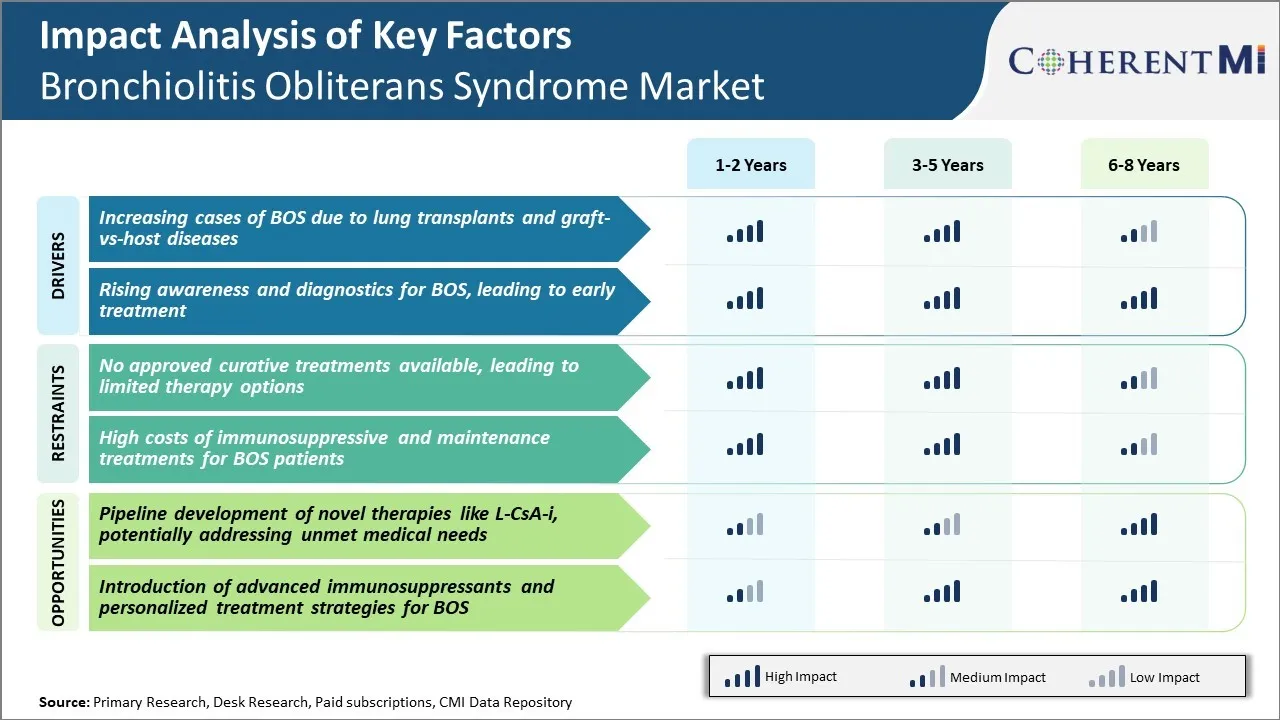Bronchiolitis Obliterans Syndrome Market Trends
Market Driver - Increasing Cases of BOS due to Lung Transplants and Graft-vs-Host Diseases
BOS involves scar tissue formation, known as fibrotic tissue growth, which narrows down the airways over the time and restricts the airflow due to rejection of transplanted lungs by body's immune system. Graft-vs-host diseases (GVHD) post hematopoietic stem cell transplantation is a major cause that increases the occurrence of BOS.
The number of patients undergoing lung transplant procedures continues to increase annually globally because lung failure has become a leading cause of mortality. While transplantation is a life-saving option for patients with end-stage lung diseases like cystic fibrosis, pulmonary fibrosis, pulmonary hypertension etc., the lifelong immune-suppressing therapy administered post-surgery has its share of risks.
According to latest data, BOS develops in nearly 30-50% of lung transplant recipients within 5 years of transplantation procedure majorly due to chronic rejection of transplanted organ. Persistent inflammation and scarring progressively destroys the small airways over time limiting air movement in and out of lungs. GVHD patients who receive stem cells from a living or deceased donor are also vulnerable to develop BOS as a long-term complication. The inflammatory destruction triggered by grafted immune cells against host tissues and organs may involve the air passages of lungs too.
Market Driver - Rising Awareness and Diagnostics for BOS, Leading to Early Treatment
Earlier, diagnosis was challenging as symptoms mimic other respiratory illnesses in the initial stages. However, improved lung function tests, high resolution CT scans and biopsy methods have enabled pathologists and doctors to detect early signs of obstruction and scarring in small airways caused by post-transplant complications.
At the same time, patient advocacy groups and support communities online are educating people about risk factors like chronic lung infections, non-adherence to medications, history of acute cellular rejection, obliterative bronchiolitis seen on transbronchial biopsy specimens.
Early diagnosis allows physicians to start treatment interventions in a timely manner before the damage to lungs becomes permanent and irreversible. Common therapeutic strategies followed include adjustment of immunosuppressive drugs, use of newer inhalers delivering steroid medications directly to small airways, photopheresis therapy, lung volume reduction surgeries. Research studies are ongoing to evaluate efficacy of drugs like Macitentan, Imatinib targeting fibrosis related pathways.
Overall, better awareness about recognizing symptoms and signs, enhanced diagnostic evaluations and availability of diversified management plan when BOS is diagnosed at initial stages are likely to improve treatment outcomes for those suffering from this lung condition. This also presents scope for avoided long term complications.

Market Challenge - No Approved Curative Treatments Available, Leading to Limited Therapy Options
There are currently no approved curative treatments available for BOS. Existing treatment options are limited and focus mainly on managing symptoms to slow disease progression. Lung transplantation is the only treatment that can potentially restore lung function, but it has a limited success rate and risks of post-transplant complications and graft rejection remain high.
The lack of effective pharmacological therapies that can directly target the underlying pathophysiology of BOS poses a major challenge for patients. It also means physicians have restricted options to choose from when treating patients at different stages of the disease. The unavailability of curative treatments is a key concern holding back the growth of the overall BOS market.
Market Opportunity - Potential of Novel Therapies
The pipeline development of novel therapies for BOS presents significant opportunities to address major unmet medical needs in the market. One promising candidate is inhaled cyclosporine A (L-CsA-i), which is being evaluated for its ability to potentially slow the progression of BOS by suppressing the immunological mechanisms involved.
Results from initial clinical studies have been encouraging, showing improvements in lung function parameters in patients receiving L-CsA-i compared to placebo. Its targeted pulmonary drug delivery approach may help achieve higher localized concentrations while reducing systemic exposure and side effects compared to oral immunosuppressants.
Success in late-stage trials could mean L-CsA-i becomes the first approved non-transplant therapy for BOS. This has the potential to transform treatment paradigms by providing physicians an effective option to manage the disease long-term. It also stands to vastly improve patient outcomes and quality of life.
This highlights the meaningful opportunities novel pipeline therapies present to significantly grow the bronchiolitis obliterans syndrome market in the upcoming years by addressing critical unmet medical needs.